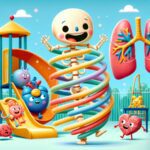Muscular Dystrophy is a term that encompasses a group of genetic disorders characterized by progressive weakness and degeneration of the skeletal muscles that control movement. For new parents, coming to terms with a diagnosis of Muscular Dystrophy in their child can be daunting. This article aims to demystify this condition, providing valuable insights into its types, symptoms, treatment options, and ways to support your child’s well-being.
What is Muscular Dystrophy?
Muscular Dystrophy represents a group of inherited conditions that lead to progressive muscle weakness and loss of muscle mass. There are several types of Muscular Dystrophy, each with its specific genetic cause and pattern of muscle weakness. The most common form in children is Duchenne Muscular Dystrophy, which primarily affects boys. Symptoms usually appear between the ages of 3 and 5 and worsen over time.
Understanding the genetic basis of Muscular Dystrophy is crucial for parents. It’s caused by mutations in the genes responsible for maintaining muscle integrity. Over time, these mutations lead to a decrease in the amount of dystrophin, a protein essential for muscle function, resulting in muscle damage and weakness. For more detailed information on the genetic aspect, visiting credible sources such as Muscular Dystrophy Association can provide in-depth knowledge.
How is Muscular Dystrophy Diagnosed in Children?
The diagnosis of Muscular Dystrophy in children involves a combination of clinical evaluation, family medical history, and specific tests. These tests may include genetic testing to identify the mutation causing the disorder, blood tests to measure enzymes released from damaged muscles, and muscle biopsies. Early diagnosis is vital to managing the condition effectively and improving the quality of life for affected children.
Parents noticing signs of muscle weakness in their child, such as difficulty climbing stairs or running, should consult a healthcare provider promptly. Early intervention strategies can significantly benefit children with Muscular Dystrophy. For information on early signs and symptoms, [this link to Muscular Dystrophy symptoms](https://babywhysandhows.com/muscular-dystrophy) in our internal link library offers further reading.
Treatment Options for Muscular Dystrophy
While there is currently no cure for Muscular Dystrophy, various treatments can help manage symptoms, increase mobility, and improve quality of life. These treatments include physical therapy, occupational therapy, speech therapy, and medications such as corticosteroids to slow muscle degeneration. Surgery may also be recommended for specific complications such as scoliosis.
It’s also essential for parents to explore supportive therapies that promote independence and enhance well-being. Adaptive equipment, such as wheelchairs and braces, can significantly improve mobility and daily activities. Consulting with a multidisciplinary team specialized in Muscular Dystrophy can provide a comprehensive treatment plan tailored to your child’s needs. For more on supportive care, consider reading about [managing Muscular Dystrophy](https://babywhysandhows.com/muscular-dystrophy).
Living with Muscular Dystrophy: Support for Families
Receiving a diagnosis of Muscular Dystrophy for your child can be overwhelming. However, with the right support and resources, families can navigate the challenges of this condition. Joining support groups can provide emotional support and practical advice from other families going through similar experiences. Educational resources and advocacy organizations offer valuable information and assistance in accessing services and care.
Furthermore, fostering a supportive home environment that encourages independence within limitations can help children with Muscular Dystrophy lead fulfilling lives. Simple modifications in the home can make daily tasks more manageable. Engaging in activities that the child enjoys and can participate in can also boost their self-esteem and sense of inclusion. For additional support strategies, visiting [resources for families](https://babywhysandhows.com/muscular-dystrophy) can offer more guidance.
Conclusion
Understanding Muscular Dystrophy and navigating the journey as a parent of a child with this condition can be challenging, but it’s not without hope. Advances in medical research continue to provide new insights into treatment options and potential therapies. By staying informed, seeking support, and advocating for your child, you can play a crucial role in managing Muscular Dystrophy and ensuring your child leads a happy, fulfilling life despite the challenges.
Remember, you’re not alone on this journey. Resources and support systems are available to help you and your child every step of the way. For more information on Muscular Dystrophy and to connect with a community of support, exploring our [Muscular Dystrophy section](https://babywhysandhows.com/muscular-dystrophy) can provide additional resources and comfort.













